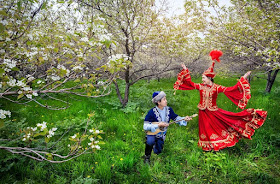Kazakh folktales
Mary Lou Masey
David McKay, 1968.
The book contains 19 folktales, translated from Russian language sources listed inside. They are not literal translations, but rather enjoyable re-tellings by the author, true to the original plot of the stories. They are accompanied by black and white illustrations, and a glossary at the end. The book was a fairly quick read; I would have enjoyed more folktales of the same style.
Highlights
The most beautiful tale in the book by far is The magic garden, in which a boy sets out to plant a beautiful garden for everyone who wants to eat the fruit, drink the water, or enjoy the shade. An evil khan tries to build a wall around it (*cough*), but the garden protect itself, and remains a shelter for all people. I also loved the story that warns that Whoever knows a tale should tell it - or otherwise the tales take revenge. In this case, it's a man's sister-in-law who rescues him from the vengeful story spirits that don't want to exist in secret.
There was a lovely story about A little camel who got lost and almost eaten by wolves. When later two man argued about who the camel belonged to, a clever judge howled like a wolf, and watched which flock the little animal ran to for shelter. The camel was a less likable character in the story about The animals' quarrel that explained the origin of the animal calendar. Since it was the mouse who saw the rising sun first in a contest (standing on the hump of the camel), the cycle starts with the Year of the Mouse.
I liked the story about the Three suitors who were all promised the same girl. Eventually, a judge discovered that the girl already loved one of them, and made sure she got to marry him. This was not the only story with clever and independent girls: The woodcutter's daughter, for example, tricked a rich man multiple times when he wanted to take all her inheritance; eventually she defeated him in a storytelling contest. In the strange tale of The magic ring, golden shoe, twigs, the hero defeated three fairy women without realizing it, and eventually, when he met them, he married all three and lived happily ever after. Even though they all ate people...
The illustration was the best thing about The stupid wolf, who was tricked by various prey animals.
Connections
There were familiar tale types in the book, such as a valiant tailor (in this case, Old Man Kurai), or puss in boots (Salakhbai and the Fox). Also, Segizbai and the Mouse-girl was a variant of the story where a father wants to give his daughter to the strongest suitor - and after Sun, Wind, and Rock, he eventually marries her to a mouse.
The resident trickster is Aldar-Kos. In one story he tricked a rich man who kept hiding food from him. There was alos a clever fox who tried to make a quail believe that World Peace is here - but the clever bird didn't fall for the trick.
Where to next?
Kyrgyzstan!



No comments:
Post a Comment